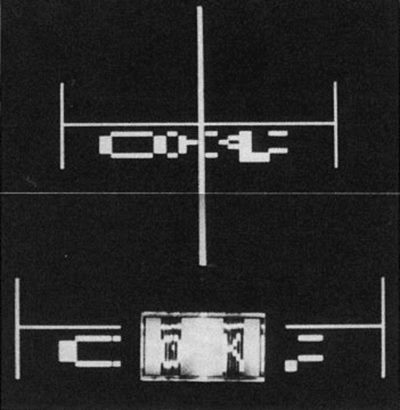

The 128K Spectrum has finally arrived. In two days time CRASH will be going to the official launch, to learn all the intimate details, including the final price announcement. There’s not much to say here about the new machine — its arrival has not been so much an If?, or a What?, but more of a When? February 13th, fortunately not a Friday...
Lloyd’s postbag has been brimming with letters on the subject of Lenslok over the last couple of weeks. Lenslok is a nifty device which could boost the life of programs it protects and thus prove a boon to the industry. Only three programs in the UK have been Lensloked so far, and the system has met with a mixed reaction from the consumer.
Lenslok has got off to a rather unfortunate start. Lenslok was effectively launched on a prestige product: Firebird’s Elite. It has suffered from not one, but two mishaps. First off, either the code used to set up the Lenslok display was incorrectly written — or at the very least, the first set of instructions that come with Elite didn’t describe the setup procedure accurately. People were unfamiliar with the new device, and quickly became frustrated. Cue a lot of aggravated Lenslok users.
Cockup Number Two arose when the wrong lens was shipped with some copies of Elite — fortunately for all concerned, only five hundred copies of the game were involved. Given the fact that each lens is a unique key, designed to work with a specific scrambling routine, this is rather like a hotel checking a guest in and issuing the wrong key. Except the guest finds out about the mistake pretty quickly, and returns to reception, rather than spending hours on hands and knees trying to get the key to fit, throwing a wobbly about locks and then either staying somewhere else or posting the key back to the hotel manager with a letter of complaint.
We’ve just used Lenslok on a copy of Elite to get the photos on this page — the Elite we borrowed from Mail Order had the right lens, but on our monitor the initial sizing display had to be set considerably wider than the lensholder for the characters to be unscrambled. The amended instructions in the package refer to a 5mm gap between the outer lines of the on-screen rules and the ends of the lens holder.

It would be a great shame if the bad feeling generated around Lenslok resulted in the idea being rejected by the legitimate software buyer — it’s the best anti-piracy device that the home computer market has seen so far. To be fair, quite a few Elite owners have written to Lloyd, saying they can’t understand what all the fuss is about, and Digital Integration, who installed Lenslok on Tomahawk report very few problems. But then they got the set-up code right and so far as they are aware Tomahawk has always been shipped with the right lens. According to the man at Digital Integration, apart from a few people who just couldn’t get on with the Lenslok system, there have been very few complaints. It doesn’t work very well with very tiny telly screens and polarising or anti-glare filters on the screen can throw the system out of line a bit — but those are minor problems.
The whole Lenslok system is still finding its feet. One software house installing Lenslok was sent an inaccurate specification of the lens they were about to use. Luckily after much hair pulling they became convinced there was a mistake and got a new specification which enabled them to make the best use of the lenses supplied before the software was mastered. Fortunate, because if the display software written to the original lens specification had not been modified to suit the lens actually produced, Lenslok would have made a lot more enemies.
Lenslok is a new product and there are bound to be teething problems. Hopefully they will soon be resolved — let’s face it, painless Lensloking should be less aggravating than unloadable Turbo and Hyperloaders...